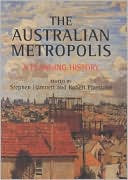

 |

|

The average rating for The Australian Metropolis: A Planning History based on 2 reviews is 4 stars.
Review # 1 was written on 2012-07-01 00:00:00 Michael Flynn Michael FlynnUrban Design presents a series of essays aimed at clarifying contemporary understanding of what is revealed as being a most elusive discipline. The various essays all support the notion of Urban Design as both critical and relevant. However, they argue that the current social, economic, cultural and political context for its engagement inhibits the potential viability of this creative design practice from its precarious location between the more policy and strategy oriented practice of urban planning and architecture. The book traces the modern trajectory of urban design to the present day from a conference held in 1956 at Harvard, chaired by the Josep Luis Sert the Catalan architect and Dean of the GSD (Graduate School of Design at Harvard) at the time . The contributors to the collection offer varied and informed perspectives on the practice, thinking and engagement of urban design in what appears to be generally perceived as the uneven and hostile fields of its operation. The varied faces and agencies of urban design are explored and examined with informative contributions highlighting theoretical, historical , practical and thematic concerns. Whilst allusions are made to Europe, Asia and Africa, the collection refers largely to the context of urban design as understood in North America and consequently the combined thrust of these erudite and enlightening essays is lacking. I would be surprised if for example German 'stadtplaner' share the view that urban design and its intellectual evolution as having originated in the USA in 1956 notwithstanding the significance of Sert's conference. The final chapter of the book comprises a round table discussion of GSD professors and other luminaries in which the contribution of the Iranian/British architect Farshid Mousaavi reinforces this issue of the Harvard/US centric bias of the book as well as the liberative potential scope of the practice as seen from a non US perspective The essential message of the texts appears to be that in a world where from 2008 onward more than half of the worlds population live in cities and that cities of over one million inhabitants now emerging every week that there is clearly a need for coherent strategies for the design of new urban environments and that those skills however configured or defined constitute urban design. The book is useful review of the history, present and future of these issues from a US perspective and is a cogent resumé of the huge and complex but engaging issues facing practitioners and theorists involved with the practice |
Review # 2 was written on 2014-08-01 00:00:00 Nicholas Moss Nicholas MossThis is the best book I have read on academic theory in urban design. It's not a how-to manual - in fact, the various authors seem to debate throughout the book as to what models work. At times, they even question the very existence of urban design, or at least its usefulness in creating good urban spaces. As a planner, I became frustrated by the history of discipline, which, beginning with the first conference at the GSD, is a history of exclusion: architects making a territory grab, leaving behind planners and landscape architects. It's really no wonder that every urban design job requires an architecture degree. Collaboration my ass. |
CAN'T FIND WHAT YOU'RE LOOKING FOR? CLICK HERE!!!